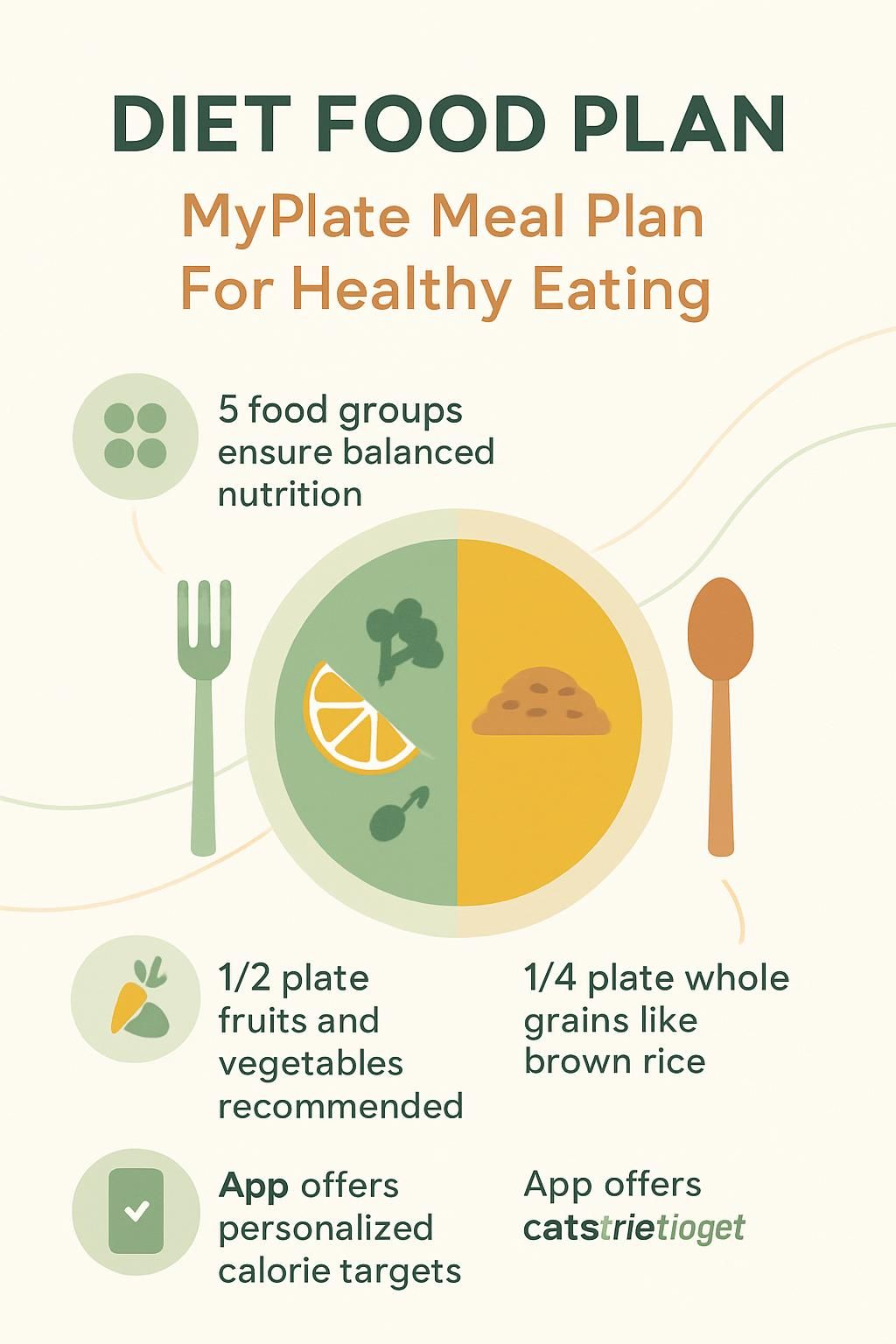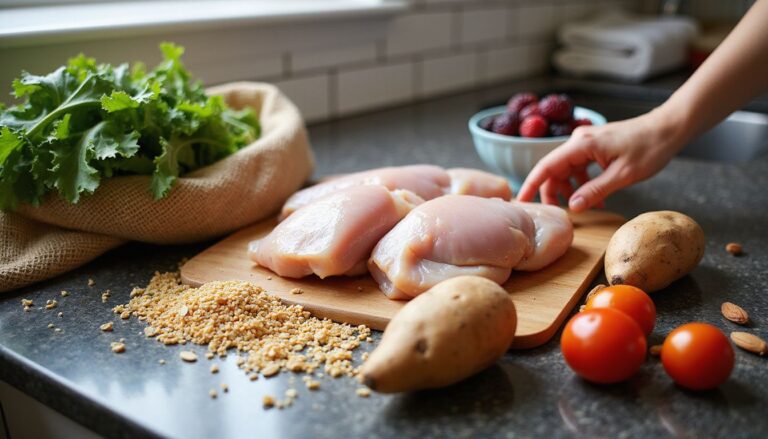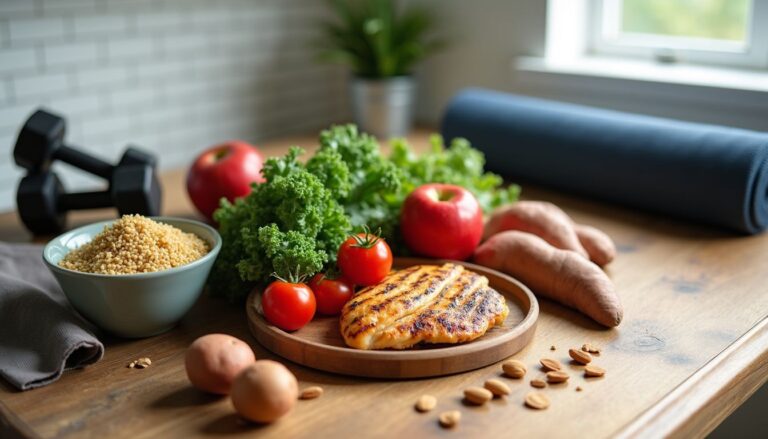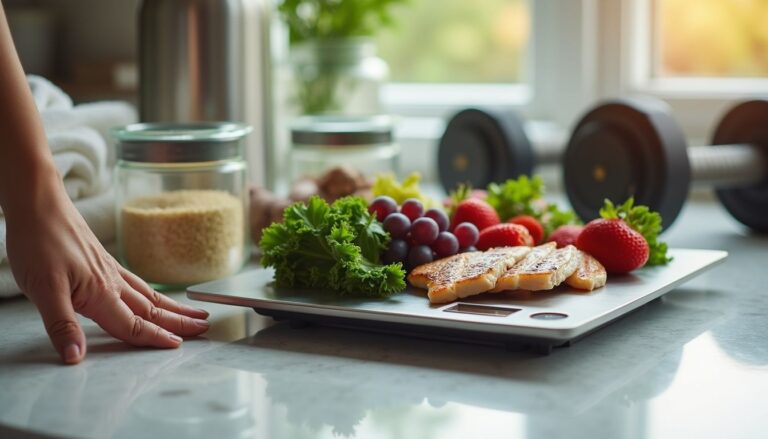Diet Food Plan: MyPlate Meal Plan For Healthy Eating
Our Nutrition Assistant AI Suite will transform your body. You will lose fat, get toned, and build muscle. Gain confidence and optimal health.
Healthy eating feels easier when you follow a clear meal plan. The MyPlate guide helps you build balanced meals, manage calorie intake, and cover all five food groups for a stronger, healthier routine.
This article shows how the MyPlate meal plan works, shares simple planning tools, and gives easy ideas for healthy meals all week. Small changes can add up quickly, and your food choices can move your health in the right direction.
Key Takeaways
- The MyPlate meal plan, created by the USDA in 2011, replaced the Food Pyramid and divides meals into five food groups for balanced nutrition.
- Research summarized by the American Diabetes Association in 2022 links MyPlate-style eating with healthier weight and a lower risk of heart disease through more fiber and fewer added sugars and saturated fats.
- Fill half your plate with fruits and vegetables, one quarter with whole grains such as brown rice, and one quarter with lean protein like chicken, fish, or beans.
- Tools such as the Start Simple with MyPlate App set personalized calorie targets using your age, sex, height, weight, and activity level, which helps with daily planning.
- Choosing low-fat or fat-free dairy like skim milk supports calcium needs while keeping calories lower. The Dietary Guidelines for Americans 2020 to 2025 offer more ways to reduce diet-related disease risk.

What is the MyPlate Meal Plan?

The MyPlate Meal Plan is a simple picture of a balanced diet built from five food groups, fruits, vegetables, grains, protein foods, and dairy. The United States Department of Agriculture launched MyPlate in 2011 to make everyday choices clear and practical.
You divide your plate into sections. Half is fruits and vegetables. One quarter is whole grains, like brown rice or whole wheat bread. The last quarter is healthy protein, such as fish, poultry, beans, or eggs. Add a serving of low-fat or fat-free dairy to round out the meal.
Portions can shift based on age, body size, activity level, and daily calorie needs. Studies show that this pattern can support heart health and help control blood pressure. It keeps added sugars and saturated fat lower and boosts dietary fiber from whole-grain foods.
Clear serving size guidance also helps with weight control. Many people find that visual portions reduce guesswork at meals and snacks.
Understanding the MyPlate Food Groups
Use the MyPlate meal plan to get a healthy mix of nutrients every day. Each food group adds different vitamins, minerals, and fiber that support steady blood sugar and long-term health.
What are the best fruits to include in MyPlate?
Fruit adds natural sweetness along with fiber and vitamins. Mixing fruit into meals and snacks can help you feel full and satisfied.
- Choose berries like blueberries, strawberries, or blackberries. They are rich in vitamin C, fiber, and antioxidants that support heart health.
- Pick oranges or tangerines for vitamin C and hydration. They make a refreshing snack in place of a sweetened beverage.
- Add apples for crunch and soluble fiber. Sliced apples work in salads or as a portable snack.
- Use bananas for potassium, a mineral that supports healthy blood pressure.
- Grab grapes for a quick snack or toss them into a side salad for vitamins K and C.
- Choose dried fruit such as raisins, apricots, or prunes with no added sugar. Keep portions small because sugars are concentrated.
- Enjoy melons like cantaloupe or watermelon. They add hydration and vitamin A for immune support.
- Add kiwi for potassium and vitamin E. Try it on plain yogurt or in smoothies.
- Pack pears for fiber. They fit easily into lunch bowls or a simple dessert.
Next, see how many servings of vegetables you need to meet MyPlate goals.
How many vegetables should you eat daily?
After planning fruits, focus on vegetables to build a nutrient-rich plate. Aim for at least two and a half cups of vegetables each day based on a 2,000 calorie diet.
Fill half your plate with vegetables at lunch and dinner to hit that mark. Choose a mix of leafy greens, carrots, tomatoes, sweet potatoes, or crunchy choices like cucumber and celery.
Different colors offer different nutrients that support your heart and help lower the risk of certain cancers. Sautéed spinach or roasted sweet potatoes add fiber and help you feel full without a lot of added sugar or fat.
Try veggie burger patties for variety or add hummus as a dip for raw vegetables. If you have medical needs such as high blood pressure or diabetes, talk with a healthcare provider or a registered dietitian for personal advice.
What counts as whole grains in MyPlate?
Whole grains include all three parts of the grain kernel, the bran, germ, and endosperm. Examples include whole wheat bread, brown rice, oatmeal, quinoa, barley, whole grain pasta, popcorn, and corn tortillas.
Refined grains like white bread or regular pasta do not count because processing removes key nutrients and fiber.
Make at least half of your daily grains whole. Whole-grain foods provide more fiber and vitamins compared with refined choices. Cooking with quinoa or eating oats adds healthy carbohydrates without extra cholesterol or excess fat.
The USDA suggests varying your whole grains at breakfast, lunch, and dinner for a balanced pattern.
Which protein foods fit the MyPlate guidelines?
Choose a variety of protein foods that keep saturated fat low and nutrients high. Pick skinless poultry, fish such as salmon or cod, eggs, and lean cuts of beef or pork like sirloin or tenderloin.
Include plant proteins often. Beans, lentils, chickpeas, peas, tofu, edamame, nuts, and seeds add fiber and healthy fats. Seafood twice a week supplies omega 3 fats that support heart health.
Swap processed meats for grilled chicken breast or roasted turkey at dinner. At the grocery store, try cottage cheese instead of cream cheese. Use hummus in place of mayonnaise on sandwiches.
At home, roast chickpeas with a drizzle of olive oil to top salads. This simple swap keeps saturated fat low while keeping meals satisfying.
What dairy options are recommended in MyPlate?
Choose fat-free or low-fat milk and dairy to get calcium, vitamin D, and protein without too much saturated fat. Try low-fat yogurt at breakfast or for a snack.
Drink a small glass of skim milk with lunch or dinner to meet MyPlate dairy targets.
Look for cheeses labeled reduced fat or part skim if you want to cut saturated fat. Fortified soy beverages are good alternatives to cow’s milk because they offer similar protein and vitamin D.
Rotate dairy choices across the week to meet calcium needs while managing calories. This supports healthy weight and heart health.
Benefits of Following the MyPlate Meal Plan
Following the MyPlate meal plan gives you practical steps for healthier eating. It helps you eat a variety of foods while keeping an eye on your daily calories.
How does MyPlate promote balanced nutrition?
MyPlate guides you to include all five groups at most meals. That means fruits, vegetables, whole grains like couscous or brown rice, low-fat dairy such as yogurt, and protein foods like baked chicken or soybeans.
Each group delivers different nutrients for strong muscles, healthy skin, and disease prevention. Use small amounts of healthy oils, such as olive or canola oil, instead of butter to lower saturated fat.
Portion guidance helps you manage calories without counting every bite. Fill half your plate with vegetables and fruits. Use a quarter for lean protein, such as lean ground beef or nuts, and a quarter for whole grains.
When you balance meals this way, you may feel steadier energy and fewer cravings for sugary snacks. This approach supports healthy weight and a lower BMI, as reported in research reviewed by the American Diabetes Association in 2022.
Can MyPlate help with healthy weight management?
Planning meals with MyPlate supports healthy weight. Fruits and vegetables are low in calories and high in fiber, which helps you feel full longer.
Choose whole grains in place of refined grains and pick lean proteins such as grilled chicken, roasted fish, beans, or nuts. Limit sauces that are high in saturated fat to trim calories.
Tracking portions with the MyPlate method makes it easier to keep intake in a safe range that fits your goals. Very low calorie plans require medical supervision and are not right for most people.* Replacing sugary drinks with water can further reduce your daily calories.
*Talk with a healthcare provider before using a restrictive calorie target.
[1] U.S. Department of Agriculture & U.S. Department of Health and Human Services: Dietary Guidelines for Americans, 2020-2025
How does MyPlate reduce the risk of chronic diseases?
Meals built with MyPlate can lower your risk of chronic disease, including heart disease, type 2 diabetes, and some cancers. Filling half your plate with vegetables and fruits boosts fiber and vitamins that help control blood pressure.
Whole grains support steady blood sugar and better cholesterol levels. Lean or plant-based proteins reduce saturated fat intake, which supports heart health.
Cooking with vegetable oils, and choosing baking, roasting, or grilling, helps you avoid extra saturated fat from frying. Drinking water instead of sugar-sweetened drinks limits added sugars linked to weight gain and diabetes risk.
MyPlate encourages variety at every age so you can meet your nutrient needs without complicated rules.
Is MyPlate easy to follow for all age groups?
Children, teens, adults, and older adults can all use MyPlate. Each group has different needs and habits, so small tweaks help.
Kids may need reminders to drink water and pick colorful veggies. Teens often skip meals, so simple grab-and-go choices make a difference. Adults juggle busy schedules and do well with quick soups, salads, and planned snacks.
Older adults may prefer softer foods, but whole grains and lean protein are still key for strength and heart health. Digital tools can make planning easier for everyone.
Use the Start Simple with MyPlate App to set goals and track food groups. It turns weekly plans into daily actions.
Tools and Resources for MyPlate Meal Planning
Digital tools can help you plan balanced meals and track your progress. They support your goals and keep healthy eating simple.
How do you use the MyPlate Plan Calculator?
Open the MyPlate Plan Calculator online. Enter your age, sex, height, weight, and activity level. The tool estimates your daily calorie needs and shows recommended servings for fruits, vegetables, grains, protein foods, and dairy.
Follow your results page to build meals that match your targets. For example, choose berries as your fruit and add whole grains at each meal. Many people print their plan and keep it on the fridge for quick reference.
Use the Start Simple with MyPlate App to track progress and get daily tips.
What features does the Start Simple with MyPlate App offer?
After you get your numbers from the calculator, this app helps you turn plans into habits.
- Log meals and snacks so you can see if you meet all five food groups each day.
- Set goals like “add one serving of berries to breakfast” or “choose a lean protein at lunch.”
- Get reminders to drink water and swap sugary drinks for better options.
- Receive tips based on your patterns, such as choosing whole grains over refined grains.
- Find quick recipes that use a mix of fruits, vegetables, whole grains, and protein.
- Try short challenges, such as adding a new vegetable to dinner or cutting added sugars in snacks.
- Create grocery lists built around MyPlate so shopping feels easier and faster.
- View simple charts that show how many servings from each group you completed.
- Access links to reliable resources and data about healthy choices and disease prevention.
How can Shop Simple with MyPlate improve grocery shopping?
Shop Simple with MyPlate helps you find healthy foods at better prices. Search for fruits, vegetables, whole grains, and low-fat dairy based on local store deals.
The app points to discounts and budget picks in each food group. You also get easy meal ideas that use these items to keep your cart balanced and affordable.
Using Shop Simple made it easier to compare prices and pick high fiber bread over a pricier brand. Buying more produce at lower cost helped me meet nutrition goals and support heart health.
What can MyPlate on Alexa do to assist meal planning?
After shopping with Shop Simple, you can use MyPlate on Alexa for menu support at home. Ask for recipes that match MyPlate, including fruits, vegetables, whole grains, lean protein, and low-fat dairy.
Alexa can suggest ideas based on your preferences and help you plan balanced meals that support a healthy heart. It can also remind you about serving sizes and track progress toward your daily food group goals.
These tips give you quick, evidence-based guidance whenever you need help deciding what to cook.
A Sample 7-Day MyPlate Meal Plan
This sample 7 day MyPlate meal plan gives you ready ideas for breakfast, lunch, and dinner. Use it as a template and swap items you enjoy.
What does Day 1’s breakfast, lunch, and dinner look like?
Breakfast: Low-fat Greek yogurt with sliced strawberries and blueberries. Add one third cup of whole grain granola for fiber, plus a small glass of skim milk.
Lunch: Grilled chicken wrap in a whole wheat tortilla with spinach, shredded carrots, and diced tomatoes. Add an apple and water.
Dinner: Baked salmon with lemon and herbs, brown rice, and steamed broccoli. Dessert is a half cup of cantaloupe cubes.
These choices cover all five MyPlate groups and keep portions in check.
What meals are planned for Day 2’s breakfast, lunch, and dinner?
Breakfast: Oatmeal topped with sliced strawberries and walnuts, plus low-fat milk for dairy.
Lunch: Grilled chicken sandwich on whole grain bread with carrot sticks and an apple. Choose water for hydration.
Dinner: Baked salmon with brown rice and steamed broccoli. Add a side salad with romaine, cherry tomatoes, and a light vinaigrette. Enjoy fat-free Greek yogurt for dessert.
Half your plate is fruits and vegetables, with lean protein, whole grains, and low-fat dairy.
What should you eat on Day 3 for breakfast, lunch, and dinner?
Breakfast: Oatmeal with sliced bananas and a handful of blueberries, plus a cup of low-fat milk.
Lunch: Grilled chicken breast over brown rice with roasted broccoli. Add half an apple on the side and water.
Dinner: Baked salmon with quinoa and steamed carrots. If you want something sweet, have a small bowl of mixed berries.
These meals give fiber, protein, and steady energy for your day.
What are the Day 4 meal options for breakfast, lunch, and dinner?
Breakfast: Oatmeal topped with sliced bananas and walnuts, paired with low-fat milk. You get fiber, potassium, and protein in one bowl.
Lunch: Grilled chicken breast on whole wheat bread with spinach, tomato, and mustard. Add baby carrots on the side.
Dinner: Baked salmon with steamed broccoli and quinoa. Drizzle a little olive oil on the vegetables. Finish with a small bowl of mixed berries.
This menu supports heart health and keeps added sugars low.
How is Day 5’s breakfast, lunch, and dinner structured?
Breakfast: Scrambled eggs, whole grain toast, and fresh strawberries. Add a glass of low-fat milk.
Lunch: Grilled chicken breast on brown rice with steamed broccoli and sliced peaches.
Dinner: Baked salmon over quinoa with roasted carrots and green beans. Nonfat yogurt is a light dessert or snack.
All five food groups appear across the day, which helps maintain focus and energy.
What meals make up Day 6’s breakfast, lunch, and dinner?
Breakfast: Whole grain toast, scrambled eggs, and orange slices, plus low-fat milk.
Lunch: Mixed greens salad with grilled chicken breast, cherry tomatoes, and shredded carrots. Have a serving of brown rice and yogurt to round out the meal.
Dinner: Baked salmon with steamed broccoli and quinoa or farro. Fresh berries for dessert add fruit without added sugar.
This layout keeps portions steady and food groups balanced.
What is the Day 7 meal plan for breakfast, lunch, and dinner?
Breakfast: Spinach and tomato omelet made with two eggs, a slice of whole grain toast, and half an orange. Add a cup of low-fat milk if you need more protein and calcium.
Lunch: Grilled chicken breast, brown rice, and steamed broccoli. Enjoy mixed berries for dessert.
Dinner: Baked salmon with roasted sweet potatoes and green beans. A small bowl of Greek yogurt finishes the day.
This day completes a full week of MyPlate style meals.
Tips for Creating a MyPlate Diet Food Plan
Smart strategies make the MyPlate approach easier to follow. Use these simple steps to build habits that last.
How do you control portions effectively?
Use smaller plates and bowls to help keep portions reasonable. Fill half of your plate with fruits and vegetables, then split the other half between whole grains and lean protein.
Measure rice or pasta with measuring cups instead of guessing. Read food labels to see serving sizes before pouring cereal or scooping peanut butter.
Pre portion snacks into small containers rather than eating from big bags. Eat slowly so your body has time to signal fullness, which can take about 20 minutes.
Packing lunches at home makes portion control easier because you set amounts ahead of time. At restaurants, ask for a to go box early and set aside half for later.
Consistency helps. Track meals with an app or a short journal if you need structure.
Why incorporate more whole foods into your diet?
Whole foods, such as fruits, vegetables, whole grains, lean proteins, and dairy, deliver vitamins, minerals, and fiber that many processed foods lack. CDC research links whole food patterns with a lower risk of type 2 diabetes and heart disease.
Picking a fresh apple or brown rice instead of packaged snacks lowers added sugars and saturated fat. Meals built on grilled chicken or quinoa often keep you full longer than fast food and make it easier to reach MyPlate goals.
How can you limit added sugars and saturated fats?
Swap sugary drinks for water, unsweetened tea, or seltzer. Read ingredient lists and choose items with little or no added sugar. Use plain yogurt, then add fruit for flavor.
Save desserts like cookies and ice cream for special times. In the kitchen, use olive oil or avocado in place of butter. Pick lean meats like chicken breast or turkey and limit processed meats such as sausage and bacon.
Choose low-fat dairy to cut saturated fat. Season with herbs and spices instead of creamy sauces to add flavor without extra calories.
Cutting added sugars and saturated fats improves heart health according to the Dietary Guidelines for Americans 2020 to 2025.[1] The American Heart Association suggests capping added sugar at 24 grams per day for women and 36 grams per day for men.
What are the best ways to stay hydrated with water?
Hydration supports digestion, energy, and focus. Aim for at least eight cups of water each day, about 64 ounces or two liters.
Carry a reusable bottle and sip often, especially on busy days. Choose plain water for most drinks instead of soda or fruit punch.
Foods with high water content can help, such as cucumbers, oranges, and watermelon. A quick check is urine color, pale yellow usually means you are well hydrated.
Adapting MyPlate for Specific Dietary Needs
You can customize MyPlate for your preferences and health needs without losing balance or nutrition.
How to follow MyPlate on vegetarian or vegan diets?
Replace animal protein with beans, lentils, tofu, tempeh, or unsalted nuts. Aim for a variety of plant proteins during the day to cover all essential amino acids.
For the dairy group, choose fortified soy milk or plant yogurts if you avoid cow’s milk. These provide protein, calcium, and vitamin D.
Fill half your plate with fruits and vegetables, including berries, leafy greens, carrots, and squash. For whole grains, use brown rice, oats, quinoa, or 100 percent whole wheat bread.
Fortified cereals can help with vitamin B12 and iron. Check labels for added sugars and sodium in plant-based products. Drink water as your main beverage.
What gluten-free options fit within MyPlate?
Many MyPlate foods are naturally gluten free. All fruits and most vegetables are safe choices. For grains, pick quinoa, brown rice, corn tortillas, and certified gluten free oats.
Eggs, chicken breast, beans, fish, and tofu fit well in the protein group. For dairy, choose low-fat milk or lactose-free yogurt if needed.
Always read labels to confirm products are certified gluten free since some foods contain hidden wheat or barley. Meal planning before you shop can reduce mistakes and stress.
How to reduce sodium while following MyPlate?
Read labels and pick items marked low sodium or no salt added. Cook at home more often so you control the salt shaker.
Use herbs, spices, lemon juice, or vinegar for flavor. Choose fresh produce since it is naturally low in sodium compared with many canned items.
Rinse canned beans and vegetables under water to remove extra salt. Pick whole grain breads and cereals with 140 milligrams of sodium or less per serving. Limit sauces, dressings, condiments, deli meats, and frozen meals, which often hide a lot of sodium.
Reduce salt gradually so your taste adjusts over time.
How to adjust calories for weight loss or gain with MyPlate?
Start with the MyPlate Plan Calculator to estimate your daily needs from your age, sex, height, weight, and activity. To lose weight, aim for a modest calorie deficit, about 500 to 750 calories below maintenance per day, if appropriate for you.
If you want to gain weight, increase your intake by 300 to 500 calories above maintenance. Choose nutrient rich foods from every MyPlate group, not just extra treats.
Track meals with the Start Simple with MyPlate App or write them in a journal. Log breakfast and snacks right after eating to stay consistent.
Keep half your plate fruits and vegetables, choose lean proteins like beans or chicken breast, and adjust portions of grains and healthy fats. For weight gain, add higher calorie whole foods like avocado or nut butter.
Summary: Use USDA MyPlate tools to set a target, adjust serving sizes of grains, protein foods, fruits, and dairy, monitor progress often, and focus on whole foods for steady results.
Additional Healthy Eating Tips
These extra tips can make MyPlate meal planning easier and help you reach your nutrition goals.
How can batch cooking simplify meal prep?
Batch cooking saves time because you prepare food in advance. Cook big batches of grains, proteins, and vegetables that match your MyPlate plan.
Store meals in labeled containers so you can grab and go. Many families report spending far less time on daily cooking when they prep on weekends.
Having food ready reduces last minute takeout. Roast a sheet pan of vegetables or grill chicken on Sunday, then build quick salads and bowls during the week.
Planning overlapping recipes also cuts food waste and grocery costs.
Why use seasonal and local ingredients?
Seasonal and local produce is often picked at peak ripeness, which can mean better flavor and more nutrients. Food grown near you spends less time in transit and may keep more vitamins.
Buying local supports your community and can lower shipping impacts. In season items like sweet potatoes or spinach often cost less, which helps you follow MyPlate on a budget.
Healthier snacks are easier when fresh food tastes great.
How to plan snacks that follow MyPlate guidelines?
Build snacks from two or three food groups. This combo keeps you full and helps you meet your goals.
Try these pairs and trios:
- Low-fat yogurt with berries, dairy plus fruit.
- Whole grain crackers with cheese or turkey, grains plus protein.
- Carrot sticks or snap peas with hummus, vegetables plus protein.
- Apple slices with peanut butter, fruit plus healthy fats and protein.
Rotate fruits like apples, bananas, and clementines. Prepare small snack boxes with nuts, cherry tomatoes, and whole wheat pita chips. Choose water to hydrate without extra sugar.
Balanced snacks can steady your energy through a busy afternoon.
Conclusion
A MyPlate meal plan offers a simple, evidence based way to eat healthy. Fill your plate with colorful fruits and vegetables, lean protein, whole grains, and low-fat dairy, then use digital tools to stay on track.
Following these steps can help you manage weight, boost energy, and reduce health risks, as shown in guidance from USDA MyPlate and the CDC.[1][2] This guide is for education. Talk with a healthcare provider or a registered dietitian before major diet changes, especially if you have a medical condition.
With a clear plan and small daily actions, healthy meals can fit your life and your budget.
[1] U.S. Department of Agriculture (USDA). MyPlate.gov.
[2] Centers for Disease Control and Prevention (CDC). Healthy Eating for a Healthy Weight.
FAQs
1. What is the MyPlate meal plan and how does it support healthy eating?
The MyPlate meal plan is a guide from the United States Department of Agriculture that shows balanced portions for each food group at meals. It encourages people to fill half their plate with fruits and vegetables, one quarter with grains, and one quarter with protein-rich foods like poultry or fish. Dairy such as milk or yogurt should be included on the side. Research supports this approach because it helps control calorie intake while providing essential nutrients.
2. How can I use data to build a diet food plan based on MyPlate?
You can use nutrition labels and serving size charts to track your daily intake of calories, vitamins, minerals, fiber, and protein. For example, studies show adults need about 2 cups of fruit and 2½ cups of vegetables per day for optimal health (Centers for Disease Control). Keeping a simple table listing what you eat makes it easier to compare your choices against these recommendations.
3. Are there benefits proven by research when following a MyPlate-based meal plan?
Yes; evidence shows that people who follow plans similar to MyPlate have lower risks for heart disease, diabetes, and obesity (Harvard School of Public Health). Eating more whole grains instead of refined ones also improves digestion according to clinical trials.
4. Can you share an example from personal experience using the MyPlate method?
After switching my lunch routine from fast food sandwiches to meals built around grilled chicken breast with brown rice plus mixed greens salad topped with beans and low-fat cheese alongside water or skim milk I noticed higher energy levels in afternoons along with better focus during work meetings.
Summary: The MyPlate meal plan uses clear guidelines supported by scientific research which help individuals make informed decisions about portion sizes nutrient balance and long-term wellness outcomes through practical steps anyone can apply daily.







